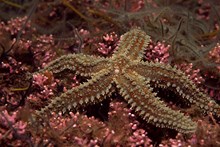20 October, 2015
Report explores recovery of habitats and species in Scotland’s new Marine Protected Areas
A new report has shown that once damaged, nationally and internationally important marine wildlife and habitats may take tens or even hundreds of years to recover.
The study, commissioned by Scottish Natural Heritage (SNH), reviewed factors that may help or limit the recovery of habitats and species such as horse mussel and maerl beds, common skate and native oysters. It also considered ways to help address any declines.
The findings will help the Scottish Government and SNH take action to look after the Scottish Marine Protected Areas (MPA) network. This will include action for Nature Conservation MPAs, which were put in place last year, partly to help support the recovery of marine habitats such as flameshell and maerl beds.
Published studies on the recovery of marine habitats and species are quite limited, but this study found that there is potential for recovery to occur if conditions are right. It also found that there is a lack of basic knowledge about the biology of some habitats and species, which is important for understanding how they might be able to recover. The need for further research in these areas was highlighted.
However it appears that several key factors influencing the timescale and the extent of recovery are common across many species and habitats. These include physical factors like the scale of the disturbance, the degree to which the habitat is broken up and having the right environmental conditions to allow a species or habitat to recolonise an area. Biological factors are also at play, such as the links between patches of a particular habitat or wildlife populations, their growth rate and ability to reproduce and spread.
The report also looked at whether restoration techniques such as reintroduction from elsewhere might help – it found this might offer potential for a limited number of species, particularly bivalves, like the native oyster and horse mussels.
It concludes that to maximise chances of recovery, any management should target the known causes of decline and take account of physical and biological factors which may be limiting recovery. For these reasons management may have to be applied at a range of scales – within parts of sites and across whole MPAs. In some cases, the relationship with management of the wider sea area may also need to be considered.
Sarah Cunningham, policy and advice officer from Scottish Natural Heritage said: “This review takes us another step forward in understanding what action we can take to address the decline of a marine habitat or species in Scotland’s seas. Not only does it give us a summary of the main factors to consider, it also, importantly, gives us a framework that will help us be more consistent when we’re thinking about how to tackle these issues. It’ll help us give wildlife in Marine Protected Areas the best chance of recovery and move towards a network of well-managed sites.”
ENDS
For media enquiries contact Nancy Fraser, SNH media & public relations officer on 0141 951 0809 or nancy.fraser@snh.gov.uk
An online copy of the report “A review of the recovery potential and influencing factors of relevance to the management of habitats and species within Marine Protected Areas around Scotland” is available at http://www.snh.gov.uk/publications-data-and-research/publications/search-the-catalogue/publication-detail/?id=2385
Marine Protected Areas
To meet international commitments, Scotland is required to create a network of well-managed Marine Protected Areas (MPAs) in Scottish waters, under the Marine (Scotland) Act and the UK Marine and Coastal Access Act. The network will protect marine wildlife, habitats and undersea landscapes from the coast to 200 nautical miles offshore. The process is led by Marine Scotland. SNH and the Joint Nature Conservation Committee (JNCC) provide information and advice about the marine environment in territorial and offshore waters respectively to Marine Scotland and Ministers so they can decide where MPAs should be. The project also includes Historic Scotland, Marine Scotland Science and the Scottish Environment Protection Agency.
More information on the Scottish MPA process is available from:
SNH: www.snh.gov.uk/marine-protected-areas/
Marine Scotland: www.scotland.gov.uk/Topics/marine/marine-environment/mpanetwork
Contact information
- Name
- SNH Media
- snhmedia@snh.gov.uk
NatureScot is Scotland's nature agency. We work to enhance our natural environment in Scotland and inspire everyone to care more about it. Our priority is a nature-rich future for Scotland and an effective response to the climate emergency. For more information, visit our website at www.nature.scot or follow us on X at https://x.com/NatureScot
’S e NatureScot buidheann nàdair na h-Alba. Bidh sinn a’ neartachadh àrainneachd na h-Alba agus a’ brosnachadh dhaoine gu barrachd suim a chur ann an nàdar. Tha e mar phrìomhachas againn gum bi nàdar na h-Alba beairteach agus gun dèilig sinn gu h-èifeachdach le èiginn na gnàth-shìde. Tha an tuilleadh fiosrachaidh aig www.nature.scot no air X aig https://x.com/NatureScot

